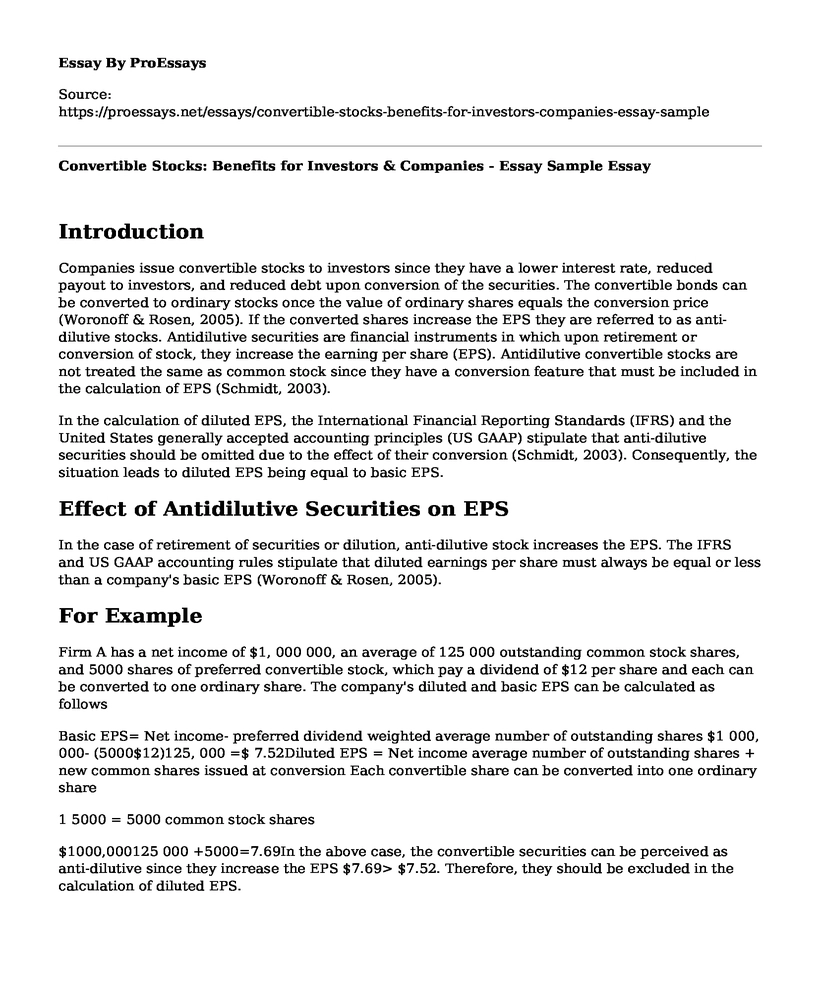Introduction
Companies issue convertible stocks to investors since they have a lower interest rate, reduced payout to investors, and reduced debt upon conversion of the securities. The convertible bonds can be converted to ordinary stocks once the value of ordinary shares equals the conversion price (Woronoff & Rosen, 2005). If the converted shares increase the EPS they are referred to as anti-dilutive stocks. Antidilutive securities are financial instruments in which upon retirement or conversion of stock, they increase the earning per share (EPS). Antidilutive convertible stocks are not treated the same as common stock since they have a conversion feature that must be included in the calculation of EPS (Schmidt, 2003).
In the calculation of diluted EPS, the International Financial Reporting Standards (IFRS) and the United States generally accepted accounting principles (US GAAP) stipulate that anti-dilutive securities should be omitted due to the effect of their conversion (Schmidt, 2003). Consequently, the situation leads to diluted EPS being equal to basic EPS.
Effect of Antidilutive Securities on EPS
In the case of retirement of securities or dilution, anti-dilutive stock increases the EPS. The IFRS and US GAAP accounting rules stipulate that diluted earnings per share must always be equal or less than a company's basic EPS (Woronoff & Rosen, 2005).
For Example
Firm A has a net income of $1, 000 000, an average of 125 000 outstanding common stock shares, and 5000 shares of preferred convertible stock, which pay a dividend of $12 per share and each can be converted to one ordinary share. The company's diluted and basic EPS can be calculated as follows
Basic EPS= Net income- preferred dividend weighted average number of outstanding shares $1 000, 000- (5000$12)125, 000 =$ 7.52Diluted EPS = Net income average number of outstanding shares + new common shares issued at conversion Each convertible share can be converted into one ordinary share
1 5000 = 5000 common stock shares
$1000,000125 000 +5000=7.69In the above case, the convertible securities can be perceived as anti-dilutive since they increase the EPS $7.69> $7.52. Therefore, they should be excluded in the calculation of diluted EPS.
Inclusion of Antidilutive Securities in Calculation of EPS
From an investor's perspective, I think anti-dilutive convertible securities should be included in the calculation of EPS since they increase returns on investments. When included in the calculation, investors can gain more dividends as opposed to when they are excluded (Woronoff & Rosen, 2005). Additionally, they should be included because they reduce the loss per share in a case that the company is performing poorly. In this case, diluted loss per share would be lower than the basic loss per share preventing the worst possible scenario for investors (Schmidt, 2003). On the other hand, as from a financial perspective, the anti-dilutive shares should not be included in the calculation of diluted EPS since they increase the EPS, which subsequently reduces a company's profit margin.
Antidilutive Securities Effect on the Stakeholder's Perspective of the Company's Financial Position
Antidilutive securities affect stakeholders' perspective of the company's financial position. Investors perceive a company that is issuing anti-dilutive convertible bonds as more financially stable than those with dilutive stocks. Dilutive shares decrease the ownership of common stock, reducing the EPS (Woronoff & Rosen, 2005). As a stakeholder, one would invest in a company that offers anti-dilutive convertible bonds or warrants since they prevent the worst scenario during dilution. Moreover, anti-dilutive convertible stock reduces a company's debt burden once it is converted to ordinary shares improving a company's financial position.
References
Schmidt, K. M. (2003). Convertible securities and venture capital finance. The Journal of Finance, 58(3), 1139-1166. https://doi.org/10.1111/1540-6261.00561
Woronoff, M. A., & Rosen, J. A. (2005). Understanding anti-dilution provisions in convertible securities. Fordham L. Rev., 74, 129. Retrieved from https://pdfs.semanticscholar.org/f5d6/da2db79c192493b609b7989870483ac2c5ec.pdf
Cite this page
Convertible Stocks: Benefits for Investors & Companies - Essay Sample. (2023, Mar 23). Retrieved from https://proessays.net/essays/convertible-stocks-benefits-for-investors-companies-essay-sample
If you are the original author of this essay and no longer wish to have it published on the ProEssays website, please click below to request its removal:
- Impact of Tax on the Market Essay
- Expansionary Fiscal Policy Essay Example
- Health Insurance in the US Essay Example
- Essay Example on Aged People Denied Long-Term Care Insurance Benefits
- Exploring Amazon's Current Operation Performance & Challenges: A 4V Model Analysis - Essay Sample
- The Consumption-Wealth Effect: Stock Market, Interest Rates, Inflation & More - Essay Sample
- Paper Example on Turnaround: Nissan Improves Efficiency, HR & Adaptation







